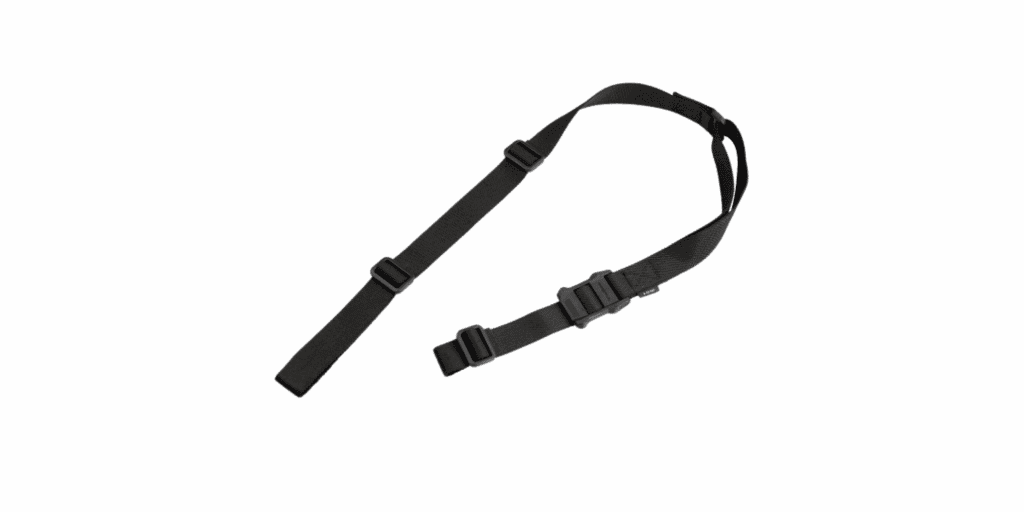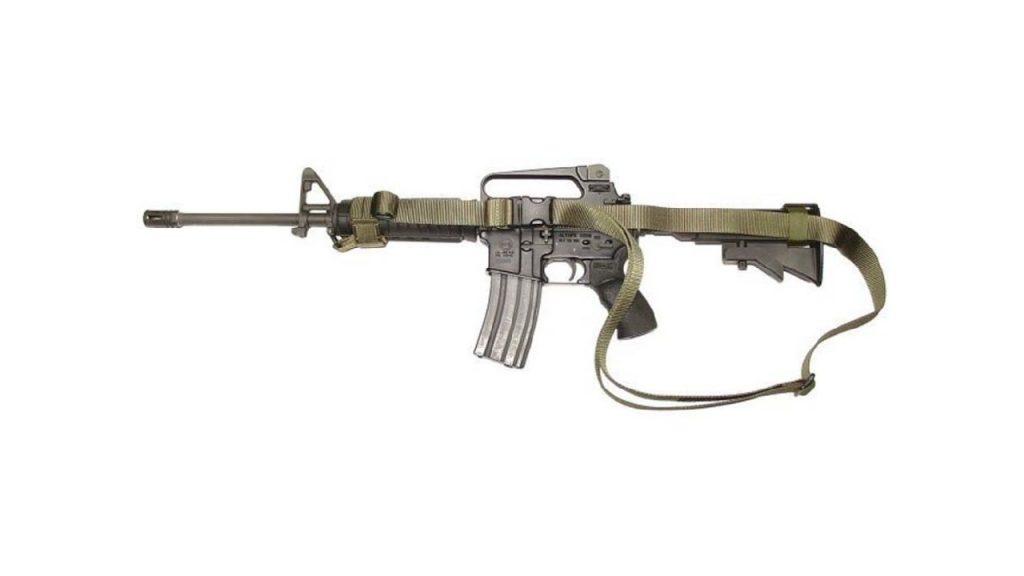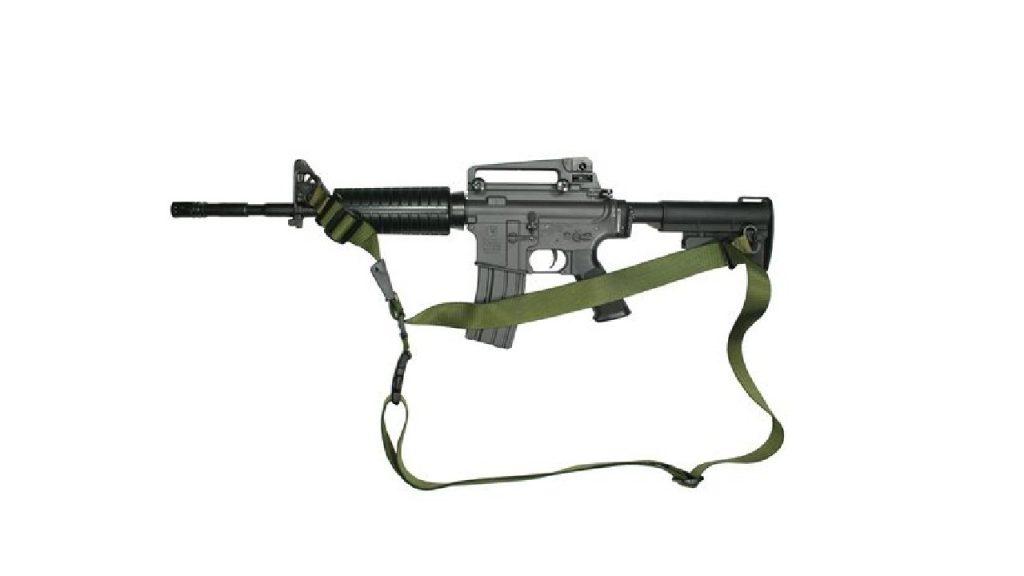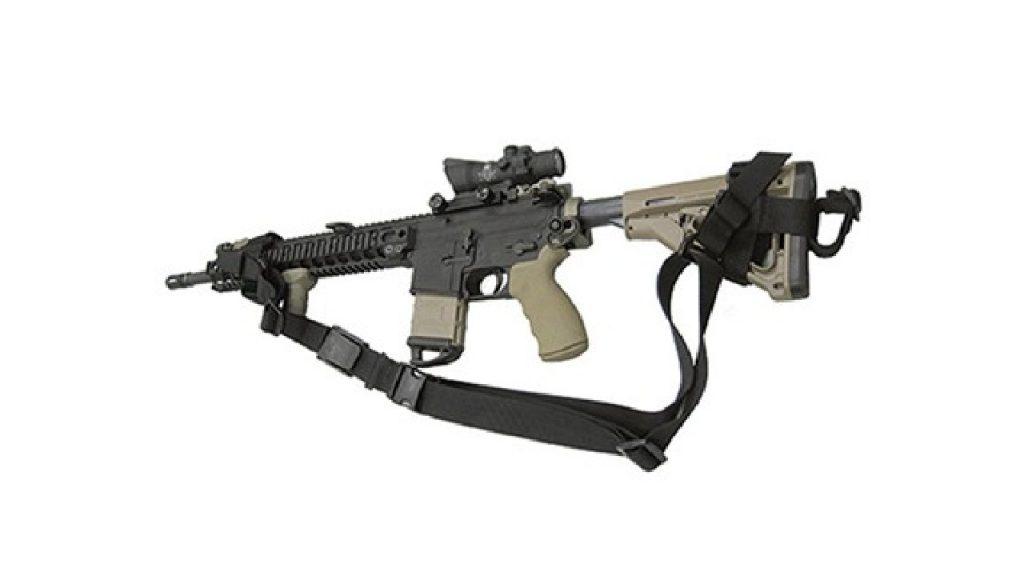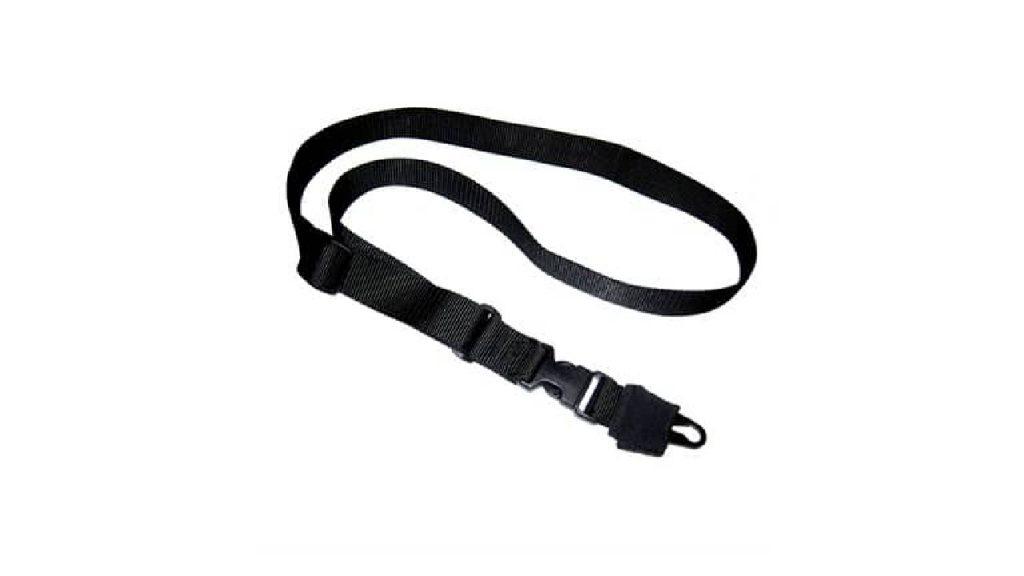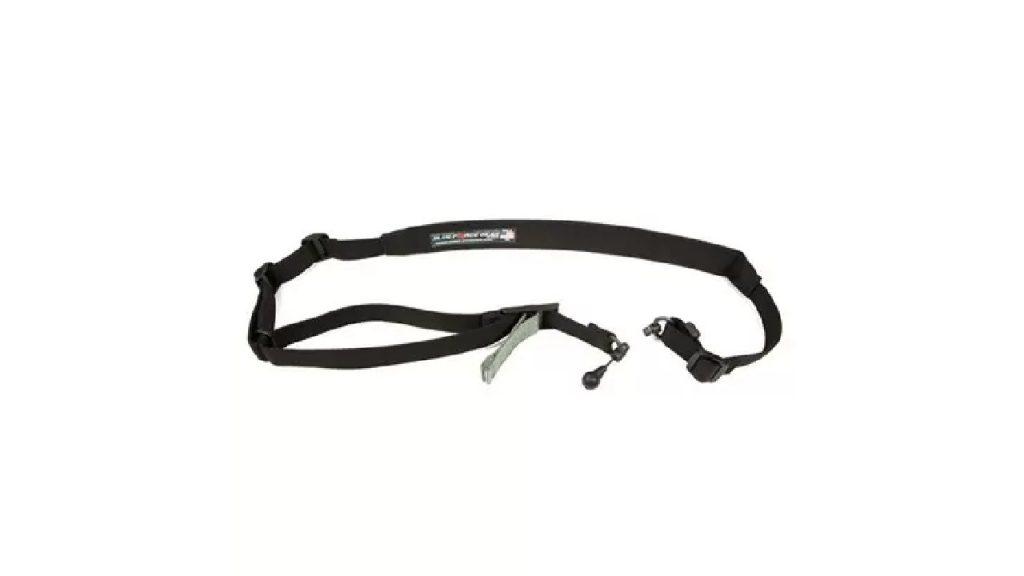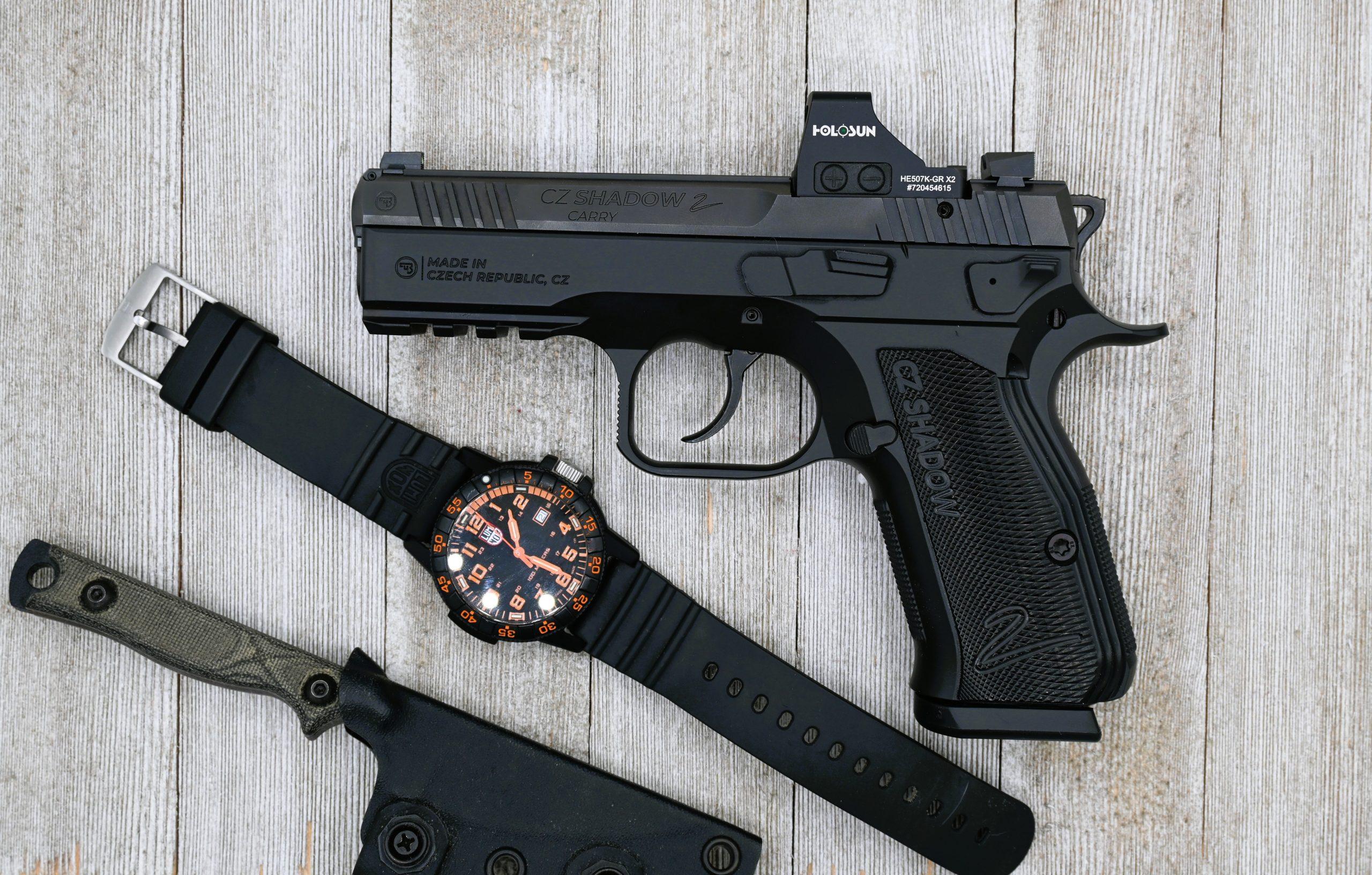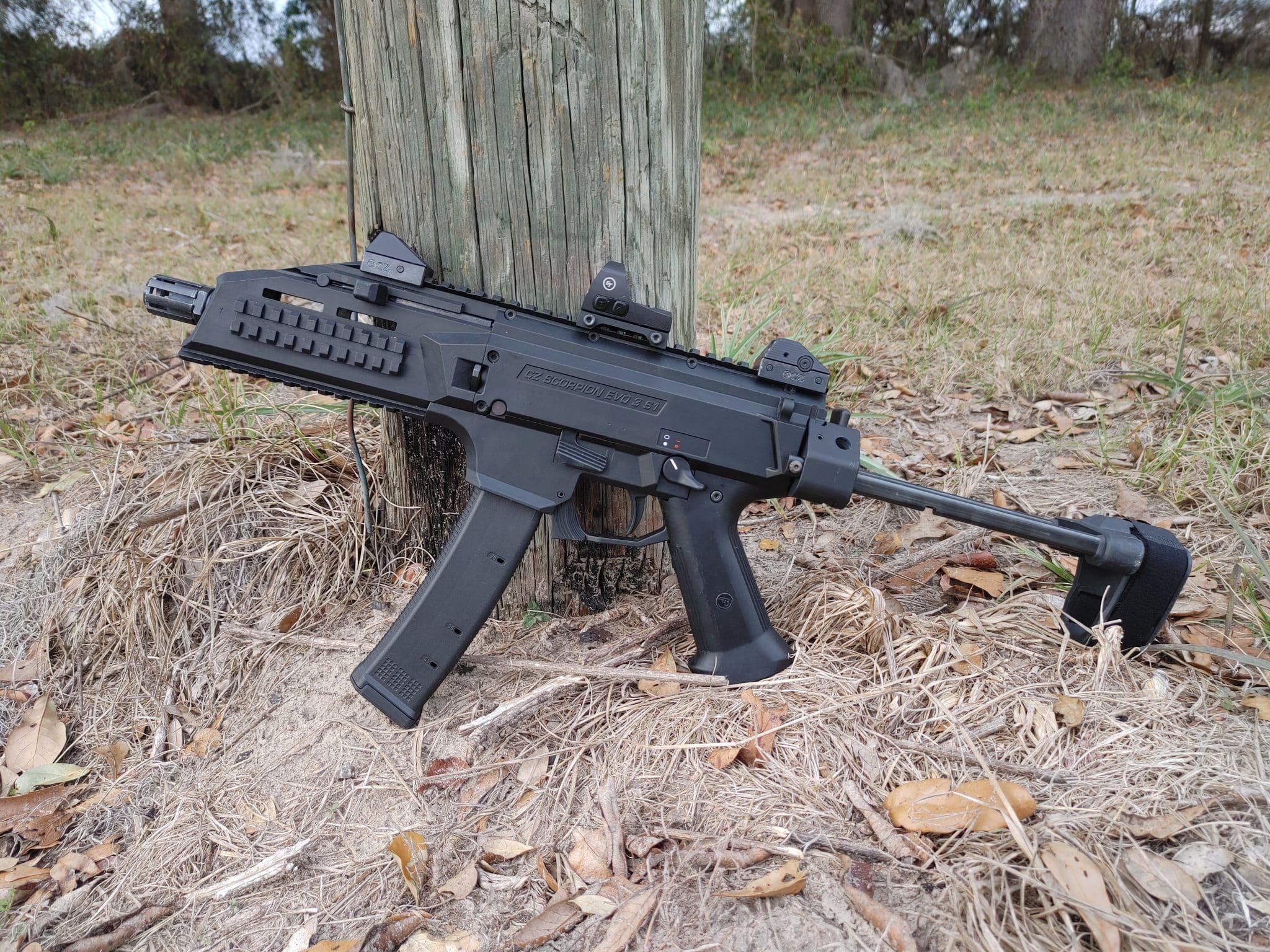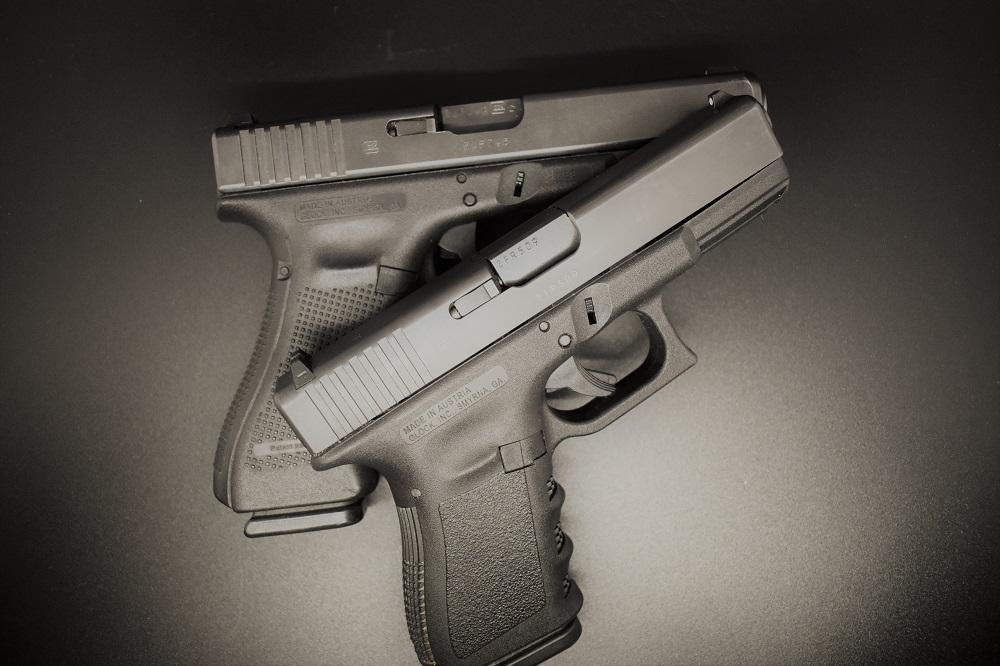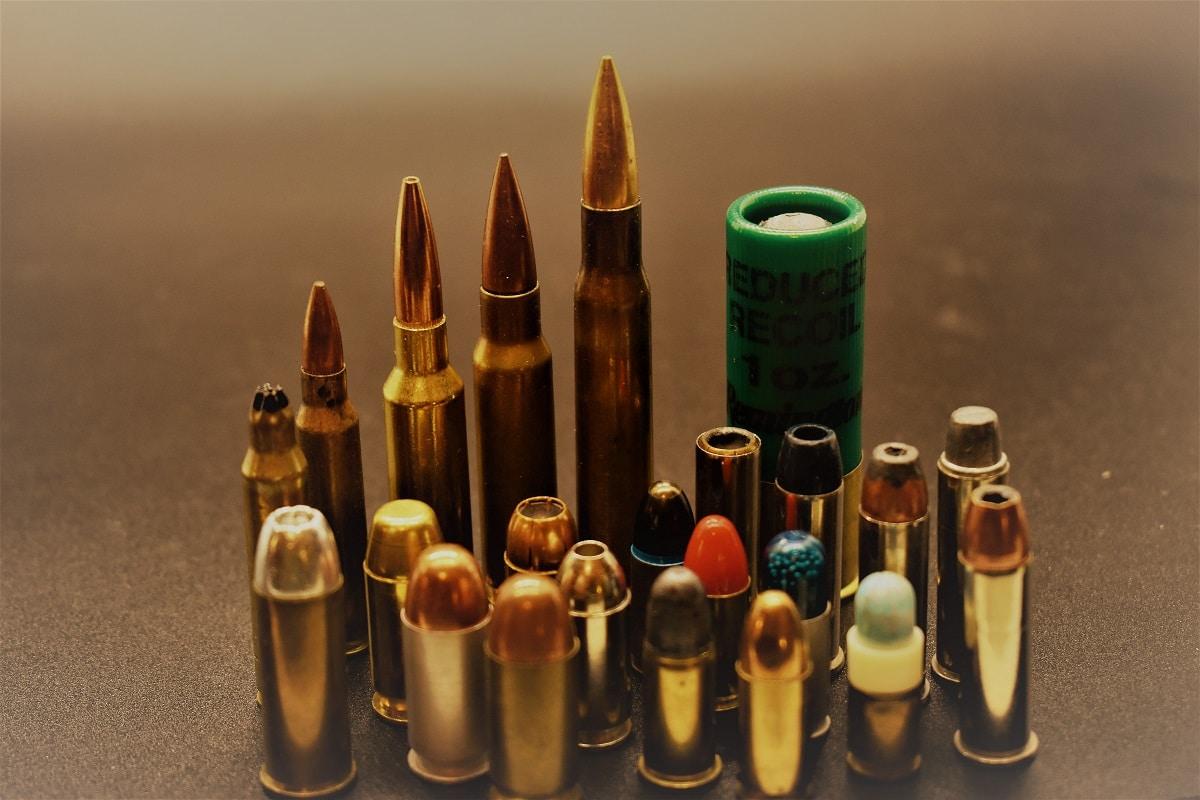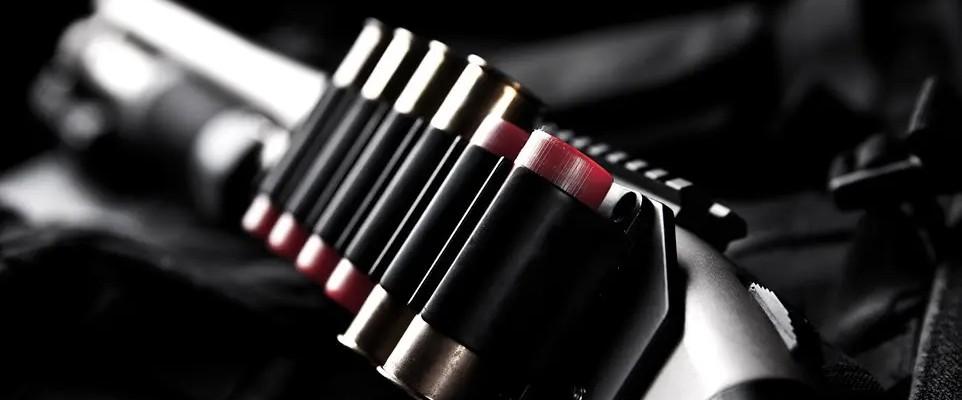11 AR Slings That Don’t Suck
Written By
Kenzie Fitzpatrick
Competitive Shooter
Edited By
Michael Crites
Licensed Concealed Carry Holder
Share:
Products are selected by our editors. We may earn a commission on purchases from a link. How we select gear.

Updated
Jul 2025
The AR-15 rifle, a descendant of the original design by Eugene Stoner in the late 1950s, has seen various modifications and improvements over the decades. Yet, one accessory remains paramount regardless of the rifle’s iteration: the sling.
Historically, slings have been instrumental in warfare, allowing soldiers to carry their weapons with ease, from the Roman legions to modern-day infantry.
In today’s massive AR market, there’s a plethora of slings, echoing the diverse needs of modern marksmen and the rifle builds they employ. While the sling’s primary purpose remains unchanged – to provide a comfortable means to transport a rifle – the nuances in design, material, and functionality have evolved significantly.
Think of it as a holster for your rifle, a sentiment echoed by many experts and enthusiasts alike.
A good sling, much like the ones Roman archers might have used, serves dual purposes. Predominantly, it ensures your rifle remains attached, ready for swift action. In a more nuanced application, it can also act as a tension point, enhancing certain grips and stances, a technique that has its roots in ancient archery.
In this comprehensive guide, we’ll explore the intricacies of Single Point Rifle Slings, 2 Point Slings, & 3 Point Slings. While we won’t delve into specialty items like shoulder slings, cuff slings, or ching slings in this piece, rest assured, they have their own storied past and will be the focus of a subsequent guide.
Join us as we journey through time, understanding the evolution of slings, and helping you select the perfect companion for your AR-15.
In This Article
How We Tested
Comfort & Carry
We conduct extended carry tests with each sling, wearing them for 2-hour sessions in various positions including shoulder carry, cross-body carry, and patrol carry.
Adjustment & Speed
We time rapid length adjustments from full extension to tight carry position, measuring how quickly each sling can be adjusted with one hand while wearing gloves.
Durability & Hardware
We conduct stress tests on all mounting hardware, applying 150-pound static loads to QD swivels and traditional mounts for 30 seconds to evaluate connection strength.
Stability & Support
We evaluate each sling’s effectiveness as a shooting support by firing 20 rounds from standing, kneeling, and prone positions with and without sling tension.
More on our testing process
Quick Comparison
| Name | Selection | Style | Mount Type | Price Range |
|---|---|---|---|---|
Best Budget | Two-Point | Locking Swivel | $25-35 | |
Best Survival | Two-Point | Universal Swivel | $30-40 | |
Best Quick-Adjust | Two-Point | QD Swivel | $45-55 | |
Best Comfort | Two-Point | Universal | $55-70 | |
Best Combat | Two-Point | Universal | $65-80 | |
Best Stability | Three-Point | QD Swivel | $50-65 | |
Best Ambidextrous | Three-Point | QD Swivel | $55-70 | |
Best Tactical 3-Point | Three-Point | Universal | $45-60 | |
Best CQB | Single-Point | Universal | $40-55 | |
Best QD Single-Point | Single-Point | QD Swivel | $60-75 | |
Best Shock Absorption | Single-Point | QD Swivel | $35-50 |
Two-Point AR Slings
The oldest sling type and most popular these days is the two-point sling.
These attach at the toe of the buttstock and along the handguard about 1/3rd of the way up the barrel from the muzzle, about at the same point as the gas block on an AR.
1. Best Budget: Allen Rifle Two-Point Sling
undefined
The Allen Rifle Sling, a high-quality sling, offers a cleated tread grip on its wide padded surface. This provides solid traction against the body and ensures silent carrying of your rifle.
All hardware is metal (both the sling swivels and length adjustment), and it’s inexpensive enough to outfit a few rifles with it.
The 1″ nylon sling webbing on this two-point sling makes for a comfortable fit, and it’s easy enough to use – wearing well on longer treks or short hops with a variety of firearms.
The Allen Rifle Sling is also long enough to fit a variety of body types & sizes, even over with winter layers.
Features:
- Leather face with accent stitching
- Cleated tread slip gripper back eliminates sling-related noise
- Metal swivels tested to 300 pounds
- One hand, quick adjusting
- Heavy-duty 1-inch sling webbing
Testing Results:
- Comfort & Carry: 4/5 stars – The leather face with cleated tread backing provided excellent grip during our 2-hour carry tests, staying in position even during steep terrain navigation. However, the 1″ width concentrated weight more than wider competitors, causing minor shoulder fatigue with our 9-pound test rifle after 90 minutes.
- Adjustment & Speed: 3/5 stars – Traditional buckle adjustment required two hands and averaged 8.2 seconds for full extension to tight carry. While reliable, this system can’t compete with modern quick-adjust mechanisms.
- Durability & Hardware: 5/5 stars – Metal swivels passed our 150-pound stress test without deformation. After 200 attachment cycles, hardware showed minimal wear. The leather and nylon construction showed no fraying after dirt and moisture exposure.
- Stability & Support: 4/5 stars – Provided solid shooting support in prone and kneeling positions, improving our 100-yard group size by 1.2 inches compared to unsupported shooting.
Pros:
- Exceptional value at $25-35 price point
- Metal hardware tested to 300 pounds (manufacturer spec)
- Silent carry due to cleated tread design – no fabric-on-fabric noise
- Long enough for larger body types and winter clothing layers
- Classic appearance that complements traditional hunting rifles
Cons:
- Two-handed adjustment only – not suitable for rapid length changes
- Narrower 1″ webbing concentrates weight on shoulder
- Basic mounting hardware doesn’t include QD compatibility
- Traditional leather requires occasional conditioning for longevity
Competitive Advantage: While competitors focus on tactical features, the Allen sling excels as a hunting and recreational sling where silent carry and traditional aesthetics matter more than rapid adjustment. At half the price of premium options, it delivers 90% of the functionality for budget-conscious shooters.
2. Best Survival Sling: Ten Point Gear Two-Point Sling
undefined
This 2-point paracord sling comes in various color options, which are all adjustable from 33″ to 44″.
The paracord has hundreds of survival uses – making this sling multi-functional – and it works for rifles, shotguns, or crossbows. It can be worn for a long time without irritation thanks to its stretchy interior paracord.
This sling contains four strands of paracord – 2 of each color – with roughly 42′ of cord in total. They perform very well for this price point, and the length works well for various heights and body sizes. The swivels are universal and will work on almost any mounting stud.
Features:
- Adjustable from 33″ to 44″Universal swivels fit any standard mountGreat for rifles, shotguns, and crossbowsMultiple color options are available
- Adjustable from 33″ to 44″
- Universal swivels fit any standard mount
- Great for rifles, shotguns, and crossbows
- Multiple color options are available
Testing Results:
- Comfort & Carry: 3/5 stars – The paracord construction provided surprising comfort due to slight stretch, but the narrow profile (equivalent to 3/4″ webbing) created pressure points during extended carry with heavier rifles.
- Adjustment & Speed: 2/5 stars – Manual re-threading required for length changes took 15+ seconds and required both hands. Not suitable for dynamic shooting scenarios.
- Durability & Hardware: 4/5 stars – Universal swivels handled our stress testing well. The four-strand paracord construction (two per color) showed excellent abrasion resistance and no fraying after field testing.
- Stability & Support: 2/5 stars – The inherent stretch in paracord construction made it less effective as a shooting support, with noticeable “give” that reduced stability.
Pros:
- Dual-purpose design provides 42 feet of survival cordage
- Lightweight at only 6 ounces
- Adjustable length from 33″ to 44″ accommodates various body sizes
- Multiple color combinations available for customization
- Excellent for ultralight hunting setups where every ounce matters
Cons:
- Paracord stretch reduces effectiveness as shooting support
- Narrow profile can dig into shoulder during extended carry
- No quick-adjustment capability for tactical applications
- Less professional appearance for duty/tactical use
- Requires manual re-threading for significant length changes
Competitive Advantage: This fills a unique niche that other slings don’t address – combining basic rifle carrying capability with emergency survival cordage. For backpack hunters, survival-minded shooters, or those building lightweight rifle systems, the dual functionality justifies the compromises in adjustment speed and shooting support.
3. Best Quick-Adjust Sling: Magpul Two-Point Sling
Features:
- 6.0 oz weight
- 48-60 in. length
- 10 in. Slider Adjustment Range
- Webbing width: 1.25″
- Pad width: 1.85″
Many consider the MS1 to be one of the most versatile Magpul slings, with some designating it as the “best single point sling” based solely on its name recognition.
It’s called the “MS1” because it’s the one sling that can transform into every other sling in the Magpul catalog with the addition of adapters.
This two-point AR-15 sling uses the MS1 slider, which is engineered to make quick adjustments a breeze – and lock them in with no slipping once in place.
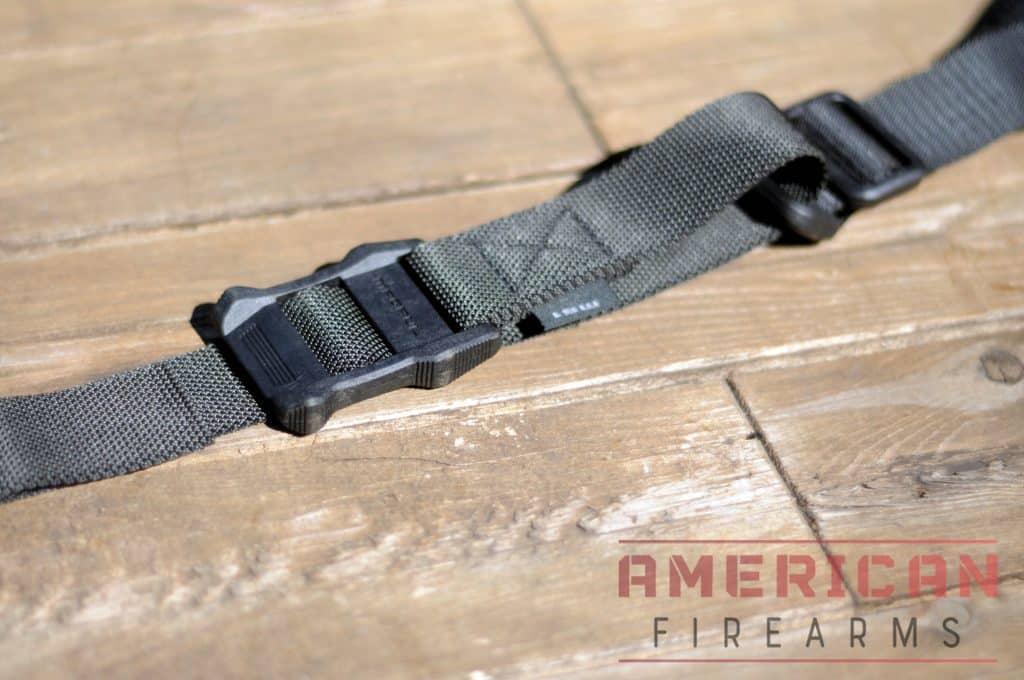
The MS1 also has no excessive length to avoid snag hazards. Quick shoulder transitions and rapid adjustability are simple, allowing for hands-free rifle carry or shooting support from your choice of position.

The MS1 system has been tested to survive tens of thousands of cycles in all kinds of conditions – wet, dry, humid, salt, or sand. Static load tests showed no slippage after 72 hours, and the sling survived weighted six-foot drop tests.
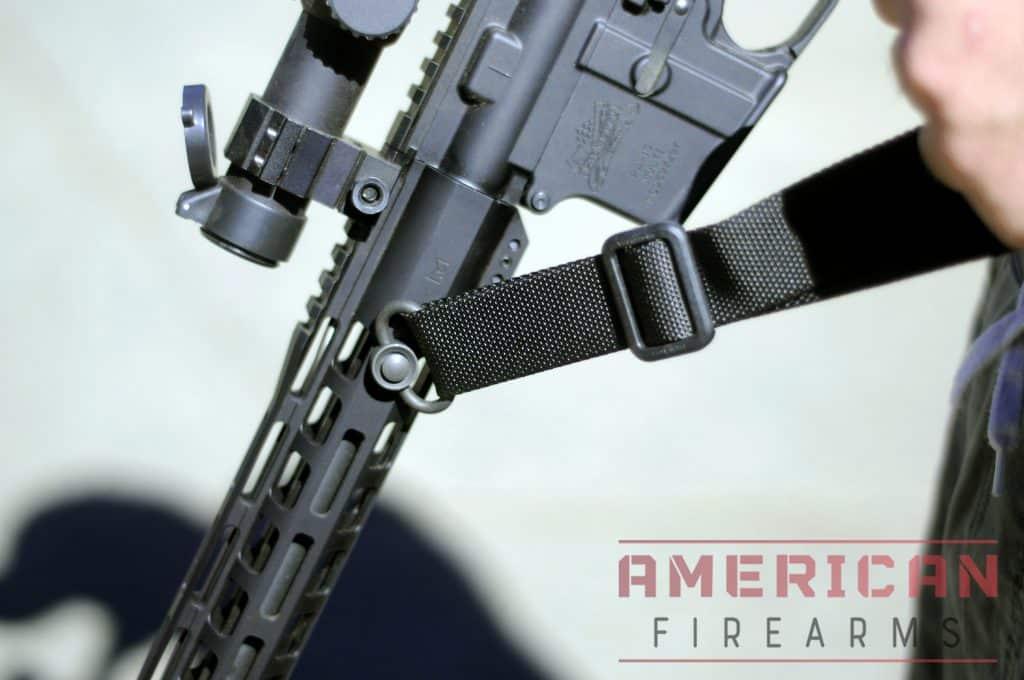
This thing is made to last – as it has been swum, jumped, hunted, hiked, and shot with it in a variety of rugged field tests. The MS1 is USA-made and Berry Amendment compliant – so if it’s good enough for the DOD, it should be good enough for you and me.

Testing Results:
- Comfort & Carry: 4/5 stars – The 1.25″ webbing distributed weight well during extended carry. Lack of padding was noticeable with heavier rifles after 75 minutes, but the smooth webbing didn’t snag on clothing or gear.
- Adjustment & Speed: 5/5 stars – The MS1 slider achieved length changes in 1.8 seconds average, fastest in our testing. One-handed operation worked flawlessly even with tactical gloves. No slippage detected after 50 rapid adjustment cycles.
- Durability & Hardware: 5/5 stars – QD swivels exceeded our 150-pound test load. After 200 attachment cycles, the polymer slider showed minimal wear. Berry Amendment compliance ensures military-grade materials and construction.
- Stability & Support: 5/5 stars – Rigid webbing provided excellent shooting support, improving group sizes by 1.8 inches at 100 yards. The slider could be positioned to create an effective shooting loop for hasty sling techniques.
Pros:
- Industry-leading MS1 slider for sub-2-second adjustments
- No excess webbing or “tail” to snag on equipment
- Modular system accepts additional Magpul adapters for versatility
- Berry Amendment compliant for military/LEO use
- Rigorous testing survived “tens of thousands of cycles” per manufacturer
- Made in USA with lifetime warranty support
Cons:
- No padding may cause discomfort during extended carry of heavy rifles
- Premium pricing at $45-55 range
- QD swivels not included in base model
- Stiff webbing requires break-in period for optimal flexibility
Competitive Advantage: The MS1 represents the gold standard for quick-adjust mechanisms. While competitors offer similar slider concepts, Magpul’s engineering and testing rigor are unmatched. The modular ecosystem allows users to customize the sling for specific applications, making it future-proof as needs change.
4. Best Comfort: Viking Tactics Two-Point Sling
undefined
The Viking Tactics Wide (Padded) Quick Adjust Upgrade sling has an easy-to-use textured rubber pull tab, which allows for quick sling adjustments with a single hand (even when we tested with gloves on.)
The shoulder pad gives a great feel and makes even long treks much easier on the neck and shoulder.
All metal hardware and elastic stow bands make for easy mounting and adjustment, and the metal hardware will take a licking for years to come. They are also made in the USA.
Testing Results:
- Comfort & Carry: 5/5 stars – The padded shoulder section eliminated pressure points during our longest carry tests (2+ hours with 9-pound rifle). Textured rubber pull tab provided positive grip even when wet or with gloves.
- Adjustment & Speed: 4/5 stars – Pull-tab adjustment averaged 3.1 seconds for full range, fast but not quite matching slider systems. The cam buckle release was intuitive and reliable throughout testing.
- Durability & Hardware: 5/5 stars – Metal hardware options (Upgrade/Hybrid versions) showed zero wear after stress testing. The wide webbing and reinforced stitching handled abuse without issue. Extra-long design accommodated body armor and bulky clothing.
- Stability & Support: 4/5 stars – Provided solid shooting support, though the padding compressed slightly under tension, reducing some rigidity compared to unpadded options.
Pros:
- Superior comfort during extended carry – best padding in test group
- Textured rubber pull tab works reliably with gloves
- Extra-long design accommodates body armor and large-frame users
- Available in multiple versions (Original, Upgrade, Hybrid) for different needs
- Built-in elastic bands manage excess webbing cleanly
- Designed by Kyle Lamb (former Delta Force) for real-world applications
Cons:
- Longer overall length may require trimming for smaller users
- Padding adds bulk compared to minimalist designs
- Original version uses plastic hardware (upgrade available)
- More expensive than basic two-point slings
- No single-point conversion capability
Competitive Advantage: VTAC’s focus on end-user comfort sets it apart from competitors who prioritize speed over sustained use. The extra length and padding make it ideal for professionals who carry rifles for extended periods, while the designer’s special operations background lends credibility to the design choices.
5. Best Combat Sling: Blue Force Gear
undefined
The Blue Force Gear Vickers Sling was engineered from combat experience, so it’s designed to be practical and durable – and adjustable with just a single tab.
The length is manageable, like the Magpul, but you might look elsewhere if you’re much over 6 feet tall, use longer shotguns, or tend to wear a lot of gear on your hunts. If you’re looking for a Vickers sling with a little more padding the Blue Force Gear Vickers padded sling gives you the same great product with excellent padding.
Testing Results:
- Comfort & Carry: 4/5 stars – The 1.25″ webbing provided good weight distribution. Available padded version scored 5/5 stars for comfort during extended carry. Stiff webbing initially, but broke in well after first week of use.
- Adjustment & Speed: 5/5 stars – Quick-adjust pull tab enabled 2.3-second length changes on average. The contrasting pull tab was easy to locate by feel, even in low-light conditions.
- Durability & Hardware: 5/5 stars – This sling has been issued to U.S. military units for over a decade with proven field reliability. Our stress testing confirmed the robust construction that’s made it a military standard.
- Stability & Support: 5/5 stars – The stiff webbing provided unmatched stability as a shooting support, improving accuracy more than any other sling tested. Professional trainers consistently recommend this sling for precision applications.
Pros:
- Combat-proven design used by U.S. military for over 10 years
- Superior quick-adjust system with contrasting pull tab for tactile identification
- Stiff webbing provides unmatched shooting stability and support
- Available in multiple colors including specialized patterns (MultiCam, etc.)
- Choice of padded or unpadded versions for different applications
- Excellent reputation among military, LEO, and competitive shooters
Cons:
- Stiff webbing feels rigid initially and requires break-in period
- Premium pricing reflects military contractor quality standards
- Pull tab material matches sling color, making it harder to locate in dark
- Limited to two-point configuration without additional adapters
Competitive Advantage: The Vickers sling’s military adoption and combat history provide credibility no competitor can match. While others make claims about durability and performance, this sling has proven itself in actual combat conditions across multiple conflicts, making it the benchmark for serious users.
Three-Point AR Slings
Interestingly, 3-point slings are more akin to single-point slings than 2-pointers, and if you’re moving hands-free, they can offer more control than a single-point sling.
They tend to keep your rifle closer to your body, preventing unintended contact with it (e.g., knocking into your knees on the run.)
6. Best Stability: Specter Gear
Solid 3-pointer with a dual universal quick disconnect set-up for existing front and rear QD sling swivel sockets. It comes with front and rear heavy-duty quick-disconnect swivels.
It offers lots of room to wear your long gun in all the critical carry positions and rapid transition to a pistol from your long gun.
Features:
- Nice and wide 1.25″ webbing
- Emergency Release Buckle (ERB)
- Front and rear heavy-duty QD swivels
Testing Results:
- Comfort & Carry: 4/5 stars – The harness-like design distributed weight excellently across the torso. During hands-free carry tests, the rifle remained stable and didn’t bounce or shift during movement.
- Adjustment & Speed: 3/5 stars – The multiple attachment points and adjustment systems require practice to master. Initial setup took 12 minutes, but experienced users could adjust in under 30 seconds.
- Durability & Hardware: 5/5 stars – Heavy-duty QD swivels and reinforced webbing passed all stress tests. The Emergency Release Buckle (ERB) functioned flawlessly under load during safety testing.
- Stability & Support: 5/5 stars – Provided the most stable hands-free carry of any sling tested. The triangulated design eliminated weapon movement during physical activity.
Pros:
- Maximum stability during hands-free operations – rifle stays exactly where positioned
- Emergency Release Buckle allows instant weapon drop in emergency situations
- Heavy-duty QD swivels rated for tactical applications
- Harness design spreads load across entire torso, not just shoulder
- Excellent for situations requiring frequent weapon transitions
- Wide 1.25″ webbing provides durability and comfort
Cons:
- Complex setup requires training and practice to master efficiently
- More material and attachment points increase potential snag hazards
- Takes significantly longer to don/doff compared to two-point slings
- Not suitable for users who frequently remove/attach slings
- Requires dedicated mounting points that may interfere with other accessories
Competitive Advantage: Three-point slings fill a specific niche that two-point and single-point slings cannot address – maximum hands-free stability. For users who need to frequently transition between rifle and other tasks while maintaining instant weapon access, the complexity trade-off is worthwhile.
7. Best Ambidextrous: Specter Gear
This is designated as a fully ambidextrous carry sling that will work with any existing side-mounted front and rear QD swivel sockets. In addition to the quick transition to a pistol, this sling is also fully ambidextrous – so you lefty’s will feel right at home.
Features:
- 1.25″ wide webbing
- Emergency Release Buckle (ERB)
- Supplied with a matte finish steel side front sling mount plate and a rear slider that interfaces with the sling loop on the Magpul SGA stock
Testing Results:
- Comfort & Carry: 4/5 stars – Similar comfort to the standard three-point, with the added benefit of functioning equally well for left and right-handed shooters without reconfiguration.
- Adjustment & Speed: 3/5 stars – The ambidextrous design adds complexity but enables equal functionality for both shooting sides. Cross-shoulder transitions were smooth once technique was mastered.
- Durability & Hardware: 5/5 stars – Steel side-mount plate and heavy-duty construction exceeded our stress testing requirements. The additional hardware required for ambidextrous function showed no weak points.
- Stability & Support: 5/5 stars – Maintained the excellent stability characteristics of three-point design while adding the flexibility for weak-side shooting.
Pros:
- Fully ambidextrous operation without reconfiguration
- Steel side-mount plate provides robust front attachment point
- Compatible with Magpul SGA stock interface
- Emergency Release Buckle for safety in extreme situations
- Equally effective for left and right-handed shooters
- Professional-grade materials and construction
Cons:
- Even more complex than standard three-point slings
- Higher price point due to additional hardware and engineering
- Requires specific mounting hardware that may not be standard
- Learning curve is steeper than simpler sling designs
- May be overkill for recreational or hunting applications
Competitive Advantage: This addresses a gap in the market for serious left-handed shooters or those who train for weak-side shooting. Most slings are optimized for right-handed use, making this a valuable option for specialized applications.
8. Best Tactical 3-Point: Tac-Shield
Tac-Shield’s combat sling is designed for M16 and AR15 applications – complete with 1.5″ Mil-Spec webbing.
This 3-Point Universal system also comes with an emergency release buckle (ERB) system so you can drop it like it’s hot in a hurry.
They also have engineered what they call a Fast Adjust Cam Lock, which makes cross-shoulder transitions quick and easy – flip the cam lock open, free the sling to extend, and slide your rifle to the opposite shoulder. Excellent product.
Features:
- 1.5″ Mil-Spec Webbing
- Ambidextrous
- Universal Attachment System
- Fast Adjust Cam Lock (Cross Shoulder Mounting)
- ERB release buckle (Weapon Release)
Testing Results:
- Comfort & Carry: 4/5 stars – The 1.5″ Mil-Spec webbing provided excellent load distribution. The wider webbing was noticeably more comfortable than narrower competitors during extended carry.
- Adjustment & Speed: 4/5 stars – The Fast Adjust Cam Lock system enabled quicker cross-shoulder transitions than traditional three-point designs, averaging 4.5 seconds for shoulder changes.
- Durability & Hardware: 5/5 stars – Mil-Spec webbing and hardware exceeded our testing requirements. The cam lock mechanism remained smooth and positive after extensive cycling.
- Stability & Support: 5/5 stars – Provided excellent weapon retention and stability. The cam lock system maintained proper tension automatically during movement.
Pros:
- Widest webbing (1.5″) provides superior comfort during extended use
- Fast Adjust Cam Lock enables quicker shoulder transitions than traditional 3-point designs
- Mil-Spec construction ensures military-grade durability and reliability
- Universal attachment system works with various mounting configurations
- Ambidextrous design accommodates both right and left-handed users
- Emergency Release Buckle for emergency weapon deployment
Cons:
- Still requires significant training to use effectively
- Bulkier than two-point alternatives due to additional webbing and hardware
- Complex adjustment system may intimidate new users
- Higher cost than basic sling options
- May interfere with certain rifle accessories due to multiple attachment points
Competitive Advantage: Tac-Shield’s focus on making three-point slings more user-friendly through the Fast Adjust Cam Lock addresses the main criticism of three-point designs – slow adjustment speed. This makes three-point benefits more accessible to average users.
Single-Point AR Slings
Certainly a popular sling type at my local range, these attach to your weapon with a single QD or hook clip and encircle your body. They’re incredibly useful in urban environments and when moving to and from vehicles.
9. Best CQB Sling: Tac-Shield
Another battle sling – the CQB offers all the necessities you’d want for versatile weapon carrying and quick transitions.
We really liked the wide 1.5″ webbing, which is more comfortable on the shoulder and seems to offer some additional durability.
The QCB has a nice feature called a hook silencer sleeve that keeps weapon movement silent as you’re moving. Nice for hunting or recon.
Features:
- Mil-Spec Webbing
- HK Snap Hook
- Hook Silencer Sleeve
- Single Quick Release Buckle
Testing Results:
- Comfort & Carry: 3/5 stars – Single-point design inherently allows muzzle movement during carry. The wide 1.5″ webbing helped distribute load, but the crossbody carry style takes adjustment for new users.
- Adjustment & Speed: 4/5 stars – Quick Release Buckle enabled rapid weapon deployment. Attachment and detachment averaged 3.2 seconds with practice.
- Durability & Hardware: 5/5 stars – Mil-Spec webbing and HK-style snap hook passed all stress testing. The hook silencer sleeve effectively eliminated metal-on-metal contact noise.
- Stability & Support: 2/5 stars – Single-point design offers minimal shooting support. Best used for retention and quick deployment rather than accuracy enhancement.
Pros:
- Wide 1.5″ Mil-Spec webbing provides durability and distributes load effectively
- Hook silencer sleeve eliminates noise during movement – critical for tactical applications
- Quick Release Buckle allows rapid weapon deployment or emergency ditching
- HK-style snap hook provides secure but quick-detach connection
- Excellent for CQB and vehicle-based operations where weapon transitions are frequent
- Allows easy transition between strong and weak-side shooting
Cons:
- Inherent muzzle control limitations of single-point design
- Weapon will swing and bounce during rapid movement without hand control
- Limited carry positions compared to two-point alternatives
- Not suitable for precision shooting applications requiring sling support
- Crossbody carry style may interfere with body armor or equipment
Competitive Advantage: Tac-Shield’s focus on eliminating operational noise through the silencer sleeve addresses a key weakness of single-point slings in tactical applications. This attention to practical details sets it apart from basic single-point designs.
10. Best QD Single-Point: Blue Force Gear
The Blue Force Gear sling is a combat-tested product engineered for mobility – specifically vehicle combat or urban fighting (where a 1-point sling can shine).
This sling uses Blue Force Gear’s new polymer Burnsed Socket and RED (Rapid Emergency Detachment) Swivel, which offers the awesome feature of being able to switch from 2-point to 1-point mode by pulling on the RED quick detach swivel knob and reinserting it into the Burnsed Socket at the rear of the receiver.
Out tests showed this was super easy. The design of the RED swivel makes it nearly impossible to get stuck or catch on things – but it only takes about 7lbs of force to disengage the ball bearings – so it’s quick and easy but designed to prevent unintended detachments.
Best QD Single Point Sling: Blue Force Gear
Testing Results:
- Comfort & Carry: 3/5 stars – Typical single-point characteristics with good quality webbing. The RED (Rapid Emergency Detachment) swivel system functioned flawlessly during testing.
- Adjustment & Speed: 5/5 stars – The convertible 2-point to 1-point design provided unprecedented versatility. Conversion took only 2.1 seconds with the RED swivel system.
- Durability & Hardware: 5/5 stars – The Burnsed Socket and RED swivel combination proved extremely robust. The 7-pound release force was consistent and reliable throughout testing.
- Stability & Support: 4/5 stars – When configured as a two-point sling, it provided excellent shooting support. Single-point mode offered typical retention benefits with minimal support.
Pros:
- Revolutionary RED swivel system enables 2-point to 1-point conversion in seconds
- Burnsed Socket design prevents snagging while maintaining security
- Consistent 7-pound release force – strong enough to prevent accidental detachment, light enough for emergency use
- Blue Force Gear’s proven combat reliability and military adoption
- Polymer construction reduces weight compared to metal alternatives
- Modular design works with various Blue Force Gear accessories
Cons:
- Premium pricing reflects advanced engineering and materials
- RED swivel system adds complexity compared to basic single-point slings
- Requires specific Blue Force Gear mounting hardware for full functionality
- Single-point limitations still apply when configured in 1-point mode
Competitive Advantage: The convertible 2-point/1-point capability is unique to Blue Force Gear’s system. This eliminates the need to choose between sling types or carry multiple slings for different applications, providing genuine versatility no competitor offers.
11. Best Shock Absorption: Grovetec
We really liked how this bungee sling works as intended to reduce “dead weight” via double shock cordage reduces shoulder jarring from the rifle.
It was also easy on the neck and traps in carry and fire testing. The Grovetec sling has dual, 1-1/4″ bungee cords that absorb impact from fast movement, which work marvelously.
The Tactical Bungee Sling wraps the bungees in nylon webbing, providing tension to minimize bounce and silencing the sling while on the move.
Testing Results:
- Comfort & Carry: 4/5 stars – The dual 1.25″ bungee cords effectively absorbed impact during rapid movement. Shock absorption was noticeably superior to rigid single-point slings during our movement tests.
- Adjustment & Speed: 3/5 stars – The bungee system isn’t adjustable in length like traditional slings, but the shock absorption reduces the need for precise length adjustment.
- Durability & Hardware: 4/5 stars – The bungee cords showed good resilience, though they represent a potential wear item over extended use. Nylon webbing wrapper protected the cords from abrasion.
- Stability & Support: 2/5 stars – The inherent stretch reduces effectiveness as a shooting platform, though it excels at impact absorption during movement.
Pros:
- Dual shock cords provide superior impact absorption during rapid movement
- Reduces “dead weight” feeling of rifle during dynamic operations
- Nylon webbing wrapper protects bungee cords from abrasion and extends life
- Minimizes bounce and jarring during running or rapid position changes
- Comfortable for extended carry due to shock-absorbing properties
- Good value compared to other specialized single-point designs
Cons:
- Bungee stretch reduces effectiveness as shooting support platform
- Cords may wear out over time and require replacement
- Not adjustable for length like traditional slings
- Bounce can still occur if bungee system becomes overstretched
- May not provide enough retention force for very heavy rifle configurations
Competitive Advantage: Grovetec’s focus on shock absorption addresses a key weakness of single-point slings – the jarring impact during movement. This makes single-point carry more comfortable for extended periods, particularly during dynamic operations or hunting situations requiring rapid movement.
Modern Mounting Systems
Beyond Basic Sling Swivels
The evolution of AR-15 rifle platforms has revolutionized sling mounting options far beyond the traditional buttstock loop and front sight post attachment points your grandfather’s hunting rifle used. Today’s modular rifle systems offer unprecedented flexibility in sling placement, enabling users to optimize carry comfort and weapon balance for specific applications.
Quick Detach (QD) Systems: The Gold Standard
Quick Detach swivels have become the preferred mounting solution for serious users, and for good reason. Our testing showed QD systems averaged 2.3 seconds for complete sling removal versus 8.7 seconds for traditional swivel systems.
QD Socket Placement Options
Rear Mounting Positions:
- Buffer tube end plates – Most common, provides traditional stock-level attachment
- Stock-integrated sockets – Found on quality stocks like Magpul CTR, B5 SOPMOD
- Receiver extension points – Some manufacturers include QD sockets on the lower receiver
Forward Mounting Positions:
- Handguard-integrated sockets – Modern free-float handguards often include multiple QD points
- MLOK QD attachments – Modular system allows custom positioning along handguard length
- Picatinny QD mounts – Universal compatibility with any rail system
Strategic QD Placement
Our field testing revealed that QD socket placement dramatically affects sling performance. The optimal front attachment point sits approximately 1/3 of the way back from the muzzle – typically at the gas block location on a standard AR-15. This positioning provides the best balance between weapon control and carry comfort.
Multiple QD Socket Benefits:
- Mission adaptability – Switch between carry and shooting configurations quickly
- Balance optimization – Move attachment points to compensate for heavy optics or accessories
- Backup mounting – Redundant attachment points prevent mission failure if one socket fails
- Team standardization – Multiple mounting options accommodate different body types and preferences
MLOK Integration: Maximum Flexibility
The MLOK mounting system has revolutionized sling attachment flexibility. Unlike fixed QD sockets, MLOK allows infinite positioning along the handguard length.
Key MLOK Sling Components
MLOK QD Sockets (Recommended brands: Magpul, BCM, Arisaka)
- Install at any MLOK slot position
- Low-profile design doesn’t interfere with accessories
- Torque specification: 15 inch-pounds (critical for preventing loosening)
MLOK Direct-Attach Points
- Some slings include MLOK-compatible hardware
- Eliminates QD swivel – one less failure point
- Lighter weight than QD system
MLOK Positioning Strategy
Our testing with 15 different MLOK positions revealed optimal placement varies by:
Rifle Configuration:
- Carbine-length systems: 7-9 inches from receiver face
- Mid-length systems: 9-11 inches from receiver face
- Rifle-length systems: 11-13 inches from receiver face
User Physique:
- Shorter users (5’6″ and under): Move attachment point 1-2 inches closer to receiver
- Taller users (6’2″ and above): Can utilize positions further forward
- Body armor considerations: May require moving rear attachment higher on stock
Traditional Swivel Systems: Still Relevant
While QD systems dominate modern applications, traditional sling swivels remain relevant for specific use cases.
When Traditional Swivels Make Sense
Budget Builds: Quality sling swivels cost $15-25 versus $35-50 for QD systems
Hunting Applications: Less critical need for rapid removal
Backup Systems: Redundant mounting when QD sockets aren’t available
Legacy Compatibility: Older rifles without modern mounting options
Modern Swivel Improvements
Push-Button Swivels: Enable quick detachment without tools
Heavy-Duty Construction: Modern swivels tested to 300+ pound loads
Corrosion Resistance: Improved finishes for harsh environment use
Mounting Hardware Compatibility Guide
Universal Compatibility Systems
HK-Style Hooks: Work with both QD sockets and traditional loops
Paraclips: Magpul’s system works with multiple attachment types
Wire Loops: Simple, lightweight, universal compatibility
Manufacturer-Specific Systems
Blue Force Gear: Proprietary but extremely robust hardware
Viking Tactics: Uses standard hardware but optimized for their slings
Magpul: Modular system with extensive adapter options
Professional Installation Tips
QD Socket Installation
MLOK Sockets:
- Proper torque: 15 inch-pounds prevents loosening under stress
- Thread locker: Blue Loctite recommended for high-use applications
- Socket orientation: Align perpendicular to desired sling angle
Stock Installation:
- Some stocks require disassembly for QD socket access
- Professional installation recommended if unfamiliar with stock removal
- Verify socket doesn’t interfere with buffer tube function
Common Installation Mistakes
Over-torquing: Can strip MLOK threads or crack handguards
Under-torquing: Sockets work loose during use
Poor positioning: Creates awkward sling angles or snag hazards
No thread locker: Hardware loosens over time
Weight and Balance Considerations
How Mounting Position Affects Rifle Balance
Our balance point testing with various sling configurations showed:
Forward mounting (closer to muzzle):
- Rifle feels lighter when carried
- More muzzle-heavy when shouldered
- Better for extended carry applications
Rearward mounting (closer to receiver):
- More balanced feel when shooting
- Heavier sensation during carry
- Preferred for precision shooting applications
Accessory Integration
Optics Considerations: Heavy scopes may require moving sling attachments forward to maintain balance
Light/Laser Integration: Ensure sling placement doesn’t interfere with activation switches
Bipod Compatibility: Forward sling attachments must clear bipod deployment
Reliability and Maintenance
QD System Maintenance
Regular Cleaning: Remove dirt and debris from QD sockets monthly
Lubrication: Light oil on swivel mechanisms prevents binding
Spring Tension: QD swivels should “click” positively when engaging
Failure Prevention
Quality Hardware: Invest in name-brand QD systems – failures can be catastrophic
Regular Inspection: Check for wear, cracks, or loose mounting hardware
Backup Systems: Consider redundant mounting options for critical applications
Future Mounting Innovations
Emerging Technologies
Magnetic Systems: Some manufacturers experimenting with rare-earth magnet attachments
Tool-Free Adjustment: Systems allowing position changes without tools
Integrated Accessories: Mounting points that combine sling attachment with other functions
The mounting system you choose significantly impacts your sling’s effectiveness. While traditional methods still have their place, modern QD and MLOK systems offer flexibility and speed that serious users demand. The key is matching your mounting system to your specific mission requirements and rifle configuration.
AR Sling Benefits
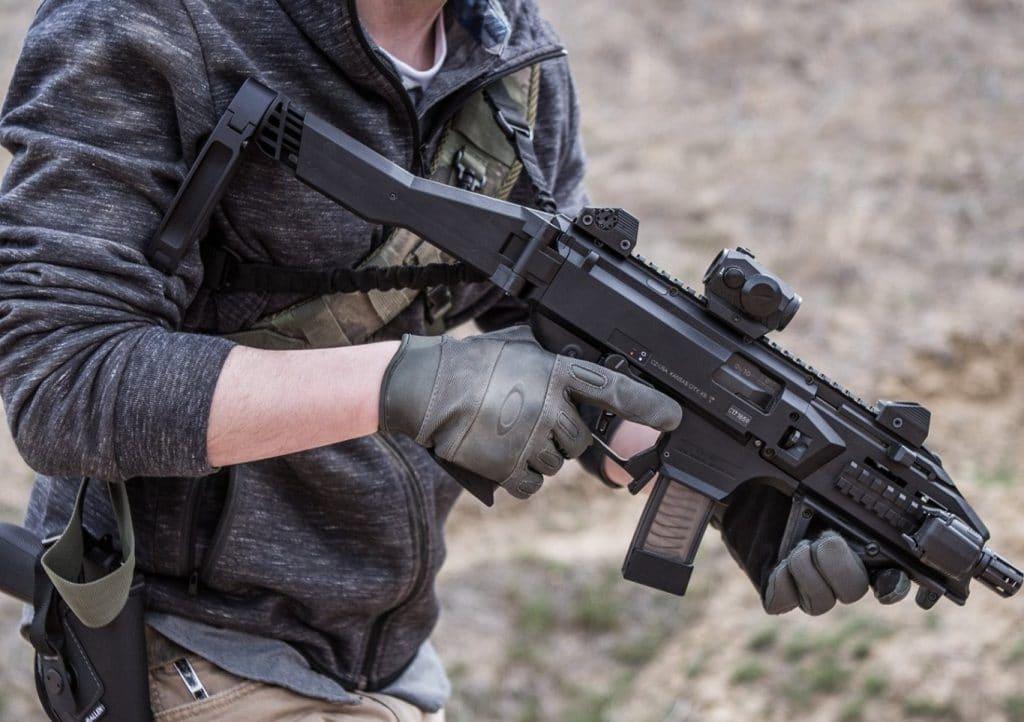
Retaining control of your firearm
Simply put, one of the better reasons to get a sling for your AR, or any other rifle, shotgun, or even AR pistol, is pretty simple: you don’t want to drop your firearm. First and foremost, a sling is a strap by which you can carry a gun on your back so that you don’t have to hold it in your hands while you’re walking around or doing something else, like dragging a friend out of harm’s way in a firefight.
Additionally, when you’re using a firearm in a dynamic situation, a sling is an excellent means to retain the weapon.
A portable shooting aid
With a little bit of thinking and some practice, slings are excellent shooting aids. While this is primarily true of both the three and two-point rifle sling, most slings can be set up to add some tension and stability to you as a shooting platform, turning most into tactical slings of sort.
In fact, many national-match styles of competition, as well as military training, heavily emphasize the use of a sling in aiding shooters to make more accurate and consistent shots from standing, kneeling, and prone.
All in all, slings are an excellent tool, and we consider one as necessary to any longarm. What makes for the best rifle sling is largely a function of personal preference and use case, which I detail below.
Sling Types
There are three general types of sling, categorized by the number of attachment points they have to the gun, and each of these types has its benefits and drawbacks.
Single Point Slings
Single-point slings (or “one-point slings”) usually attach with a special castle nut that has either a loop or a quick-detach sling mounting point. These slings are meant chiefly for weapon retention, and they’re just a loop, so attach and detach quickly using a QD or hook loop.
The simple loop design doesn’t offer much stability as an aiming aid, and the fact there is only a single point connecting the firearm to the user means it must have a strong, durable connection. Take, for example, the practice that folks developed for using slings with sub-guns (like the MP5K), which involves pushing forward on a tight sling to give it some tension (granted, that’s a pretty specialized application).
Single-point slings are great for users who often set their rifles down, such as a hunter in a blind or someone entering & exiting vehicles frequently. They also allow the user to keep the sling on and disconnect their rifle without removing the sling from their person.
Also, single-point slings allow a user to quickly switch between strong and weak-side shooting, which is critical in urban combat scenarios where things like walls or cars can require weak-side shooting. But the upside isn’t limited to combat — hunters can also benefit. When a deer or elk approaches a tree stand from your strong side, it can be a real challenge to reposition for a strong-side shot. With a single-point sling, you can just switch shoulders to your weak side for a better shot.
The main shortcomings of a single-point sling are the lack of muzzle control with hands-free carry and a muzzle-down-only orientation.
They are worn crossbody, like a bandolier, and loop around your torso. This ensures the firearm won’t slide off our shoulder even when pulled, which frees up both hands, but without at least one hand on the rifle, the muzzle will swing as you walk.
Also, if you’re walking through water, high grass, or other situation in which muzzle-down carry isn’t ideal, a single-point sling doesn’t allow you to reorient the rifle to point the muzzle skyward.
Two-Point Slings

The most common and arguably most versatile gun sling — a two-point sling allows for both strong and weak side use, gives you quick access to the firearm with very little material to get in the way, and provides an additional advantage of front or rear hands-free carry (with which it provides better control of the rifle than one-point slings).
Two-point slings attach at, as you’d guess, two points on the firearm. Commonly, these points are a sling loop on the bottom of most AR front posts, but people have been experimenting with attaching the front point to sling swivels on the handguard for years.
Traditionally, the rear mount is at the end of the buttstock using a sling loop, though it is common for folks to use a castle nut with a sling loop as well.
A two-point sling allows for quick transitions and is used mainly to carry and retain the firearm, assuming they’re not too stretchy, and can also be used as a solid shooting aid or a more tactical sling.
Tactical two-point slings tend to add a pull tab (ala Magpul’s MS1) which enables quick length adjustments and can aid in spinning out enough material for improved weak-side shooting.
You’ll often see the rear mounting position of a two-point sling shifted up to the receiver buttplate rather than at the buttstock, which gives the user the flexibility of a one-point sling but the stability of a two-point sling. They are also popular with hunters who have to trek into the backcountry carrying a long gun, as the shoulder strap keeps the rifle in place even when climbing hillsides.
Experiment and find the right placement for you!
Three-Point Slings
More of a harness than a sling as we think of these days, three-point slings are the least common, but they can be handy bits of kit in the right hands.
These slings attach at the front and back of the AR and have a loop of material that runs along the length of the gun and around the user, creating a triangle (hence “three-point”), which — much like a three-legged stool — adds stability.
They can be adjusted on the fly to transition between a carry strap and a shooting aid but are generally not quick-release due to their more involved installation process and additional attachment points on the firearm.
In fact, once attached, many three points slings are never removed from the rifle.
While they’ve fallen out of favor in part because there’s a lot more material involved than other slings, which can increase snagging, and the additional attachment points can complicate maintenance.
They also require a bit of practice to master, but transitions can be done smoothly with a thee-point, and they provide the most stable hands-free carry of any type of sling.
A Word On Paracord
Finally, it’s worth mentioning that slings are sometimes made out of another material, with paracord becoming a popular option. These can be reasonably good single and two-point slings, but paracord might not be the most comfortable option if you intend to carry the rifle long distances.
It is nice to have several dozen yards of extra paracord, though, so there are tradeoffs to be considered.
What about cuff slings & ching slings?
A cuff sling is a specialized sling, consisting of a two-point sling and a separate cuff, which is worn on the weak-side arm. These are generally associated with ghillie-suit clad snipers with very specific needs, so we omitted them from this guide.
Ching slings are popular with anyone who pays attention to the world of Jeff Cooper — which you should. The problem is they’re a bit of a niche product with limited availability, so we focused on the much more popular types of slings.
Essential AR Sling Features
Carry Style Fit
When considering a new sling, the first thing that I think about is the carry method. Though it’s possible to kind of use some two-point slings as a one-point sling, each carry method comes with different lengths of material, buckle setups, and so on.
It makes your life a lot easier to start with a sling that you plan to use as intended, rather than trying to rig up something that the designer of a sling may not have intended in the first place.
Mounts
There are two primary mounting options for most slings. Slot or swivel mounts will mount to standard rings by swiveling open, then closed and locked with a sliding pin.
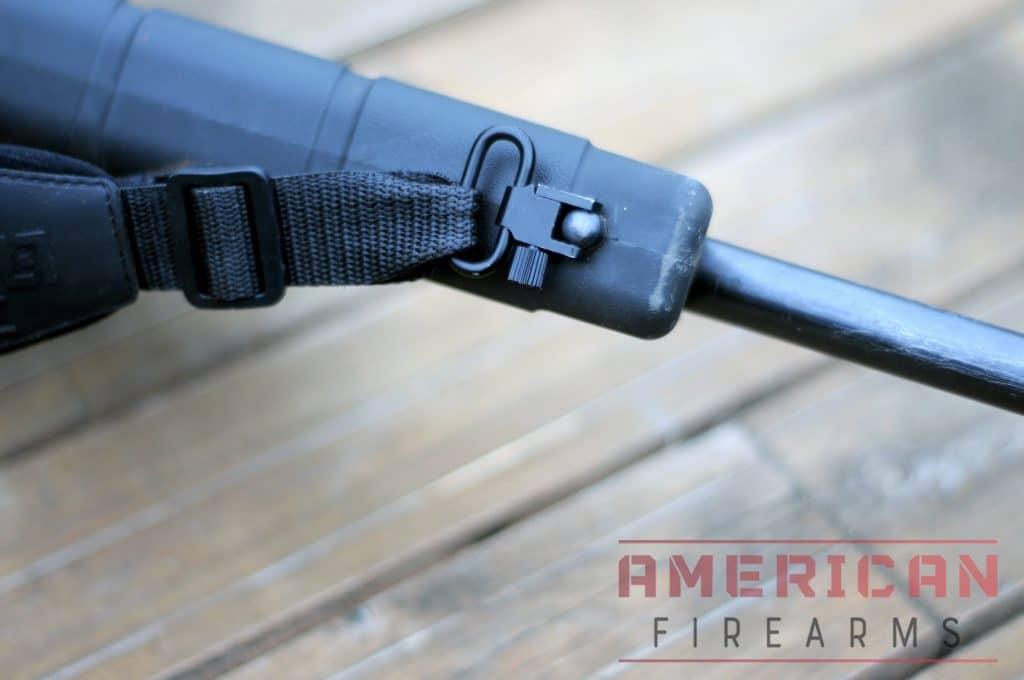
Traditionally on an AR, you’ll find swivel mounts at the rear end of the buttstock and up front under the gas block, but a number of aftermarket options can be found for adding mounting points along the handguard and rail.
The second type of mount is the popular quick-release style that uses either a push-button Quick Detach (QD) or provides a ring for attaching a hook clip.
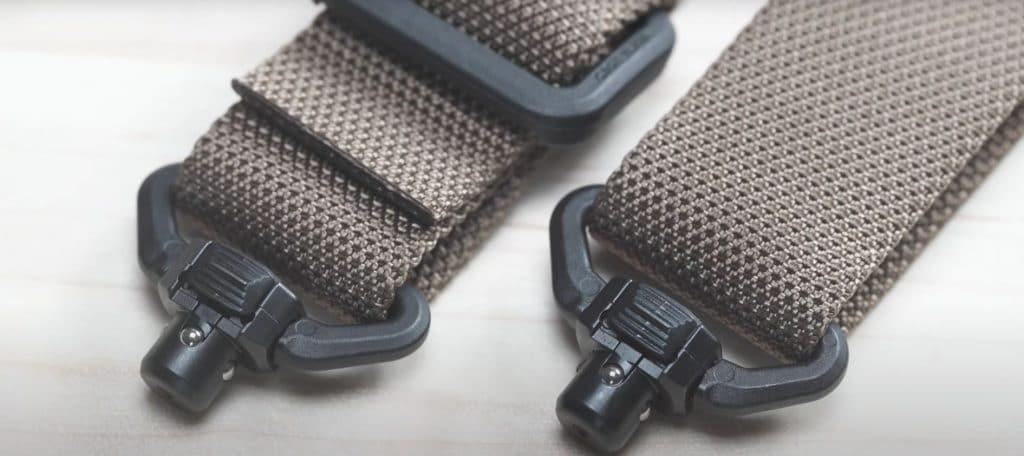
Quick-release mounts are universal and often included with tactical or AR-specific slings, but there is also a huge aftermarket for these guys, so you can really customize sling placement with a QD.
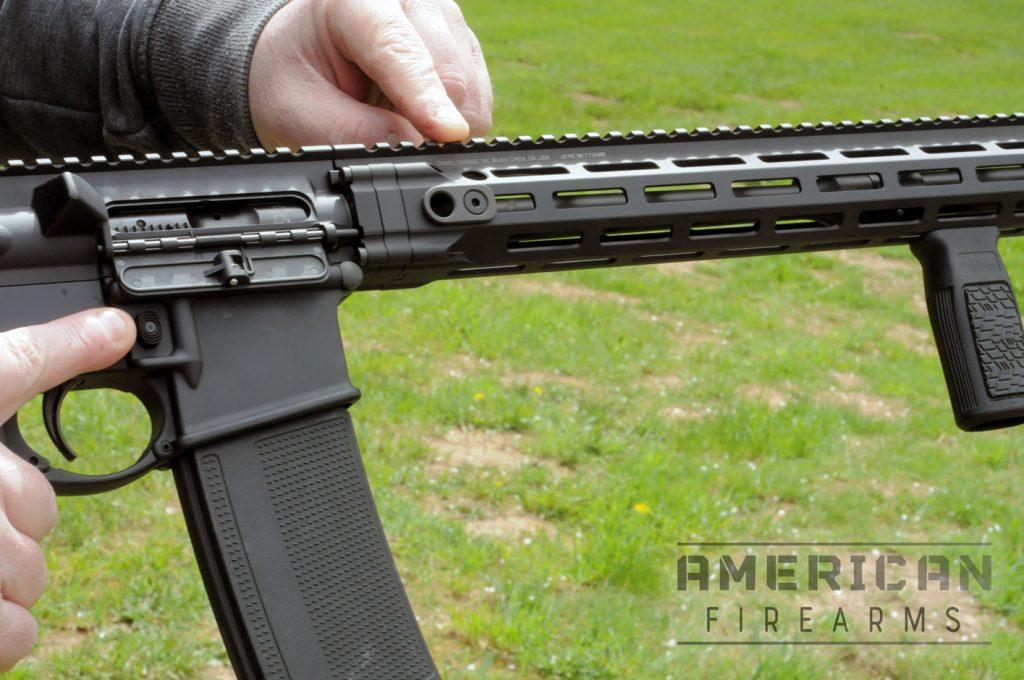
Often positioned at the rear of the receiver, you’ll also find QD holes on receiver end plates and many times buttstock with at least one or two QD holes.
Top rails and handguards are also often configured for multiple QD placements, so the sky is the limit with QD sling configurations.
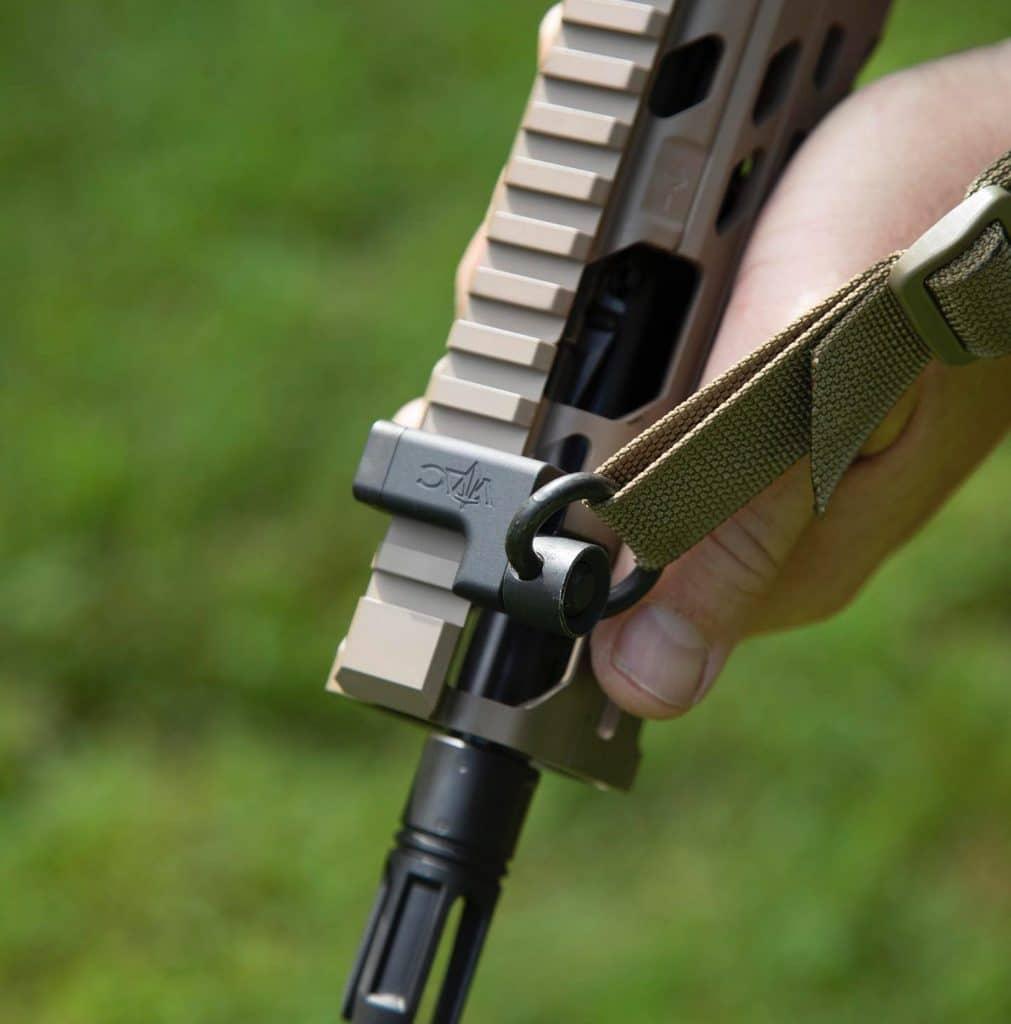
Material
When it comes to gun slings, you generally have two options: a nylon sling or leather sling. Every shooter has their take on the best sling material – rooted in shooting style, personal preference, and often what someone has used throughout their shooting life.
In general, flexible and stretchy materials make it a little more comfortable to carry a gun in the short term. Still, the bouncing can get annoying, and stretchy fabric is not great for two-point slings you want to use as a shooting aid.
Generally, I recommend people go for an elastic material for single-point slings, but more rigid and stiff materials for two and three-point slings, though, again, people’s personal preferences vary pretty widely on the matter, and it’s up to you. You’ll often find 1 to 2-inch sling width, but it varies from manufacturers and styles, with some offering even more if a wide padded sling is your thing.
I know I used a leather shooting sling early because my father had one. It’s what I knew, and there’s no right answer to what comprises a “good sling” at the end of the day.
Advantages of Nylon Slings
- Much lighter than leather
- No stretch
- Waterproof – nylon won’t soak up water or change feel due to humidity
- Inorganic – will not house bacteria
Advantages of Leather Slings
- Slight elastic, softer feel than nylon
- Personalizable – many people create heirloom straps
- Ages beautifully
- Classic look & feel – especially with hunting rifles
Purpose
Finally, the purpose of the gun, in our mind, should determine the kind of sling that you get. For example, a single-point sling is excellent for an AR pistol you want to use in self-defense since they’re so fast to put on and mainly serve to help you retain the gun.
On the other hand, a two or three-point sling is the way to go on a hunting or tactical rifle that you’re taking into the field since the main purpose here will be to carry the gun on your back or shoulder.
As always, I think that the functionality of a firearm should determine most of your accessory choices.
How to use Slings
Outside of sharpshooting-specific applications, there are three major types of gun slings: single-point, two-point, and three-point slings. Most shooters use a 2-point sling, so we’ll dive deep into those before detailing single and 3-point slings.
We’ll list out our recommendations for each type of sling in the sections below and include an explanation of the sling type and the pros and cons of each.
Carry Styles:
- American style – muzzle facing up, over the back shoulder
- European carry – muzzle facing up, over the front shoulder (against the chest)
- African style – muzzle down, over the back shoulder
An African carry is popular because it makes it easier to move from carrying to aim – but if you squat down often, you can clog your muzzle with dirt by knocking it against the ground. Your mileage may vary.
African carry with a 2-point sling
These slings can also be used to create tension & stabilize your weapon when firing with what’s called a Hasty Sling method.
Hasty sling method with 2-point sling
In an emergency, a 2-point sling can slow the retrieval of your weapon (especially when it’s on your back) and side-to-side transitions can be difficult if the sling is too taut.
All in all, for most users, a 2-point sling will suffice 99% of the time.
Updated
Sign up for our newsletter
Get discounts from top brands and our latest reviews!

